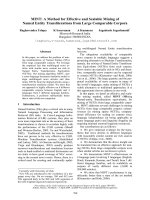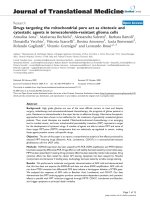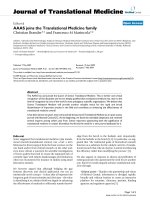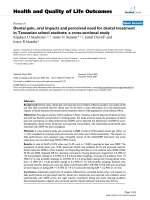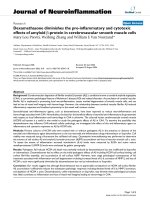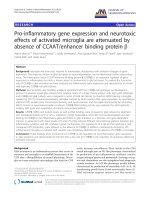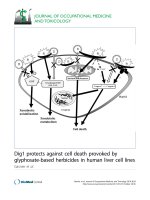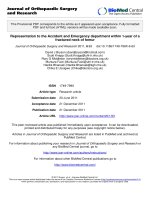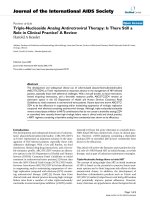báo cáo hóa học: " Dexamethasone diminishes the pro-inflammatory and cytotoxic effects of amyloid β-protein in cerebrovascular smooth muscle cells" docx
Bạn đang xem bản rút gọn của tài liệu. Xem và tải ngay bản đầy đủ của tài liệu tại đây (531.93 KB, 8 trang )
BioMed Central
Page 1 of 8
(page number not for citation purposes)
Journal of Neuroinflammation
Open Access
Research
Dexamethasone diminishes the pro-inflammatory and cytotoxic
effects of amyloid β-protein in cerebrovascular smooth muscle cells
Mary Lou Previti, Weibing Zhang and William E Van Nostrand*
Address: Department of Medicine, Health Sciences Center, Stony Brook University, Stony Brook, NY 11794-8153, USA
Email: Mary Lou Previti - ; Weibing Zhang - ; William E Van
Nostrand* -
* Corresponding author
Abstract
Background: Cerebrovascular deposition of fibrillar amyloid β-protein (Aβ), a condition known as cerebral amyloid angiopathy
(CAA), is a prominent pathological feature of Alzheimer's disease (AD) and related disorders. Accumulation of cerebral vascular
fibrillar Aβ is implicated in promoting local neuroinflammation, causes marked degeneration of smooth muscle cells, and can
lead to loss of vessel wall integrity with hemorrhage. However, the relationship between cerebral vascular fibrillar Aβ-induced
inflammatory responses and localized cytotoxicity in the vessel wall remains unclear.
Steroidal-based anti-inflammatory agents, such as dexamethasone, have been reported to reduce neuroinflammation and
hemorrhage associated with CAA. Nevertheless, the basis for the beneficial effects of steroidal anti-inflammatory drug treatment
with respect to local inflammation and hemorrhage in CAA is unknown. The cultured human cerebrovascular smooth muscle
(HCSM) cell system is a useful in vitro model to study the pathogenic effects of Aβ in CAA. To examine the possibility that
dexamethasone may influence CAA-induced cellular pathology, we investigated the effect of this anti-inflammatory agent on
inflammatory and cytotoxic responses to Aβ by HCSM cells.
Methods: Primary cultures of HCSM cells were treated with or without pathogenic Aβ in the presence or absence of the
steroidal anti-inflammatory agent dexamethasone or the non-steroidal anti-inflammatory drugs indomethacin or ibuprofen. Cell
viability was measured using a fluorescent live cell/dead cell assay. Quantitative immunoblotting was performed to determine
the amount of cell surface Aβ and amyloid β-protein precursor (AβPP) accumulation and loss of vascular smooth cell α actin.
To assess the extent of inflammation secreted interleukin-6 (IL-6) levels were measured by ELISA and active matrix
metalloproteinase-2 (MMP-2) levels were evaluated by gelatin zymography.
Results: Pathogenic Aβ-induced HCSM cell death was markedly reduced by dexamethasone but was unaffected by ibuprofen
or indomethacin. Dexamethasone had no effect on the initial pathogenic effects of Aβ including HCSM cell surface binding, cell
surface fibril-like assembly, and accumulation of cell surface AβPP. However, later stage pathological consequences of Aβ
treatment associated with inflammation and cell degeneration including increased levels of IL-6, activation of MMP-2, and loss of
HCSM α actin were significantly diminished by dexamethasone but not by indomethacin or ibuprofen.
Conclusion: Our results suggest that although dexamethasone has no appreciable consequence on HCSM cell surface fibrillar
Aβ accumulation it effectively reduces the subsequent pathologic responses including elevated levels of IL-6, MMP-2 activation,
and depletion of HCSM α actin. Dexamethasone, unlike indomethacin or ibuprofen, may diminish these pathological processes
that likely contribute to inflammation and loss of vessel wall integrity leading to hemorrhage in CAA.
Published: 03 August 2006
Journal of Neuroinflammation 2006, 3:18 doi:10.1186/1742-2094-3-18
Received: 03 April 2006
Accepted: 03 August 2006
This article is available from: />© 2006 Previti et al; licensee BioMed Central Ltd.
This is an Open Access article distributed under the terms of the Creative Commons Attribution License ( />),
which permits unrestricted use, distribution, and reproduction in any medium, provided the original work is properly cited.
Journal of Neuroinflammation 2006, 3:18 />Page 2 of 8
(page number not for citation purposes)
Background
Deposition of the amyloid β-protein (Aβ) in brain is a
prominent pathological feature of Alzheimer's disease
(AD) and a number of related disorders [1,2]. Aβ is a 39–
43 amino acid peptide that exhibits a high propensity to
self-assemble into β sheet-containing oligomeric forms
and fibrils. Aβ peptides are proteolytically derived from a
large type I integral membrane precursor protein, termed
the amyloid β-protein precursor (AβPP) through sequen-
tial cleavage by β- and γ-secretase activities [1,2]. Cerebral
parenchymal Aβ deposition can occur as diffuse plaques,
with little or no surrounding neuropathology, or as dense,
fibrillar plaques that are associated with dystrophic neu-
rons, neurofibrillary tangles, and neuroinflammation
[1,2]. In addition to plaques in the brain parenchyma,
another prominent site of extracellular Aβ deposition is
within and along primarily small and medium-sized arter-
ies and arterioles of the cerebral cortex and leptomeninges
and in the cerebral microvasculature, a condition known
as cerebral Aβ angiopathy (CAA) [3,4]. In contrast to the
dichotomous nature of diffuse or fibrillar parenchymal
plaques, CAA largely exists as fibrillar Aβ deposits [3-5].
Accumulation of cerebral vascular fibrillar Aβ has been
shown to cause marked degeneration and cell death of
smooth muscle cells and pericytes in affected larger cere-
bral vessels and in cerebral microvessels, respectively [4-
7]. Recent findings have implicated cerebral microvascu-
lar Aβ deposition in promoting neuroinflammation and
dementia in AD [8-11].
In addition to the prominent CAA that is found in AD and
in spontaneous cases of this condition, several mono-
genic, familial forms of CAA exist that result from muta-
tions that reside within the Aβ peptide sequence of AβPP
gene [12-15]. The most recognized example of familial
CAA is the Dutch-type disorder that causes early and
severe cerebral vascular amyloid deposition [16]. Dutch-
type CAA results from a E22Q substitution within the Aβ
peptide [12]. Pathologically, this disorder is characterized
by vascular amyloid-associated neuroinflammation and
recurrent, and often fatal, intracerebral hemorrhages at
mid-life [17-19].
Neuroinflammation associated with CAA is a chronic
process that involves well-recognized cellular mediators
including reactive astrocytes and activated microglia, as
well as inflammatory cytokines and chemokines [20,21].
Additionally, cerebral vascular smooth muscle cells and
pericytes, which degenerate in the presence of accumu-
lated amyloid, may directly participate in the inflamma-
tory process contributing to cognitive decline, cerebral
vessel wall degeneration, and hemorrhage [3-7]. Recent
case reports have emerged demonstrating that steroidal
anti-inflammatory treatments aimed at reducing CAA-
induced neuroinflammation and associated pathology in
afflicted individuals have improved the cognitive deficits
and recurrent hemorrhage associated with this particular
condition [22-25]. However, the basis for the success of
steroidal anti-inflammatory dugs in treating the patholog-
ical consequences of CAA remains unknown.
To investigate how steroidal anti-inflammatory agents
may suppress CAA-related inflammation and vessel wall
pathology, we determined the effects of dexamethasone
on Aβ-induced pathologic responses in human cerebrov-
ascular smooth muscle (HCSM) cells, a well-established
in vitro model of CAA. Our results indicate that although
Aβ accumulation and fibril formation on the surface of
HCSM cells was not affected, dexamethasone effectively
reduced the levels of IL-6, MMP-2 activation, and loss of
smooth muscle α actin, processes that precede HCSM cell
death and likely contribute to inflammation and loss of
vessel wall integrity in CAA.
Methods
Materials
Dulbecco's modified Eagle medium (DMEM) and fetal
bovine serum was obtained from Gibco-BRL (Grand
Island, NY). Dexamethasone, ibuprofen, and indometh-
acin were obtained from Sigma (St. Louis, MO) and resus-
pended as 1 mM stocks in ethanol. The Live/Dead Euko
Light Viability/Cytotoxicity Kit was obtained from Molec-
ular Probes (Eugene, OR). Human AβPP-specific mono-
clonal antibody (mAb) P2-1 was prepared as described
[26]. The anti-human Aβ mAb6E10 was from Signet Lab-
oratories (Dedham, MA) and the anti-smooth muscle cell
α actin mAb1A4 was obtained from Sigma (St. Louis,
MO). Immunoblotting reagents were from Amersham
(Arlington Heights, IL). The human IL-6 ELISA kit was
obtained from BioSource (Camarillo, CA).
Dutch mutant A
β
40 peptide
The E22Q Dutch mutant Aβ40 peptide was synthesized by
solid-phase F-moc amino acid substitution and purified
by reverse-phase HPLC. The structure of the peptide was
verified and the purity determined by electrospray mass
spectrometry and amino acid sequencing by automated
Edman degradation. Dutch mutant Aβ40 peptide was pre-
pared in hexafluoroisopropanol, resuspended in sterile
dimethyl sulfoxide to a concentration of 5 mM, then
diluted to 25 μM in DMEM prior to addition to the HCSM
cells. Under these conditions, upon resuspension in
DMEM the peptide exhibited a nonaggregated structure in
the culture medium throughout the six days incubation
period used in the experiments.
Cell culture
HCSM cells were established from meningeal blood ves-
sels obtained at rapid autopsy as described [27]. Three dif-
ferent lines of primary HCSM cell cultures were used in
Journal of Neuroinflammation 2006, 3:18 />Page 3 of 8
(page number not for citation purposes)
the present experiments. The HCSM cells were cultured in
DMEM containing 10% fetal calf serum and antibiotics.
The cells were passaged at a 1:4 split ratio and used
between passages 4–8 for all experiments. HCSM cells
were incubated for six days in the presence or absence of
freshly prepared 25 μM Dutch mutant Aβ40. HCSM cells
were administered daily with dexamethasone, ibuprofen,
or indomethacin to a final concentration of 1 μM. Control
HCSM cells received vehicle only. Cells were routinely
viewed using an Olympus IX70 phase contrast micro-
scope to monitor cellular degeneration. At the conclusion
of the experiments the loss in HCSM cell viability was
measured using a fluorescent live cell/dead cell assay as
described [28].
Quantitative immunoblotting
For analysis of cellular proteins, the culture medium was
collected and the cells rinsed with phosphate-buffer
saline. The cells were then solubilized in a buffer consist-
ing of 50 mM Tris-HCl, 150 mM NaCl, pH 7.5 containing
1% SDS, 5 mM EDTA, and Complete proteinase inhibitor
cocktail (Roche, Indianapolis, IN). The cell lysates were
centrifuged at 14,000 × g for 10 min to remove insoluble
material. The protein concentrations of the resulting
supernatants were determined using the BCA kit (Pierce,
Rockford, IL). The cell lysate samples were stored at -70°C
until analysis. Measurement of cell-associated AβPP, Aβ,
and smooth muscle cell α actin were performed by quan-
titative immunoblotting using mAbP2-1, mAb6E10, and
mAb1A4, respectively. Purified protein or cell lysate sam-
ples were electrophoresed on SDS 10% polyacrylamide
gels for AβPP and smooth muscle cell α actin or 10–20%
gradient gels for Aβ. The proteins were then electroblotted
onto nitrocellulose membranes and the unoccupied sites
were blocked overnight with a solution of Tris-buffered
saline containing 5.0% nonfat dried milk and 0.05%
Tween-20. The membranes were then incubated with the
appropriate antibody (1:1000) and, after washing, bound
primary antibody was detected with a peroxidase-coupled
anti-mouse IgG (1:200). The peroxidase activity on the
membranes was detected using Supersignal Dura West
(Pierce) and the corresponding bands were quantitated
using a VersaDoc Multi-Imager (BioRad Laboratories,
Hercules, CA) with the manufacturer's Quantity One soft-
ware.
Quantitation of HCSM cell surface A
β
HCSM cells were grown to near confluency in 24-well tis-
sue culture plates, placed in serum-free culture medium
overnight, and then incubated in the absence or presence
of 25 μM Dutch mutant Aβ40 with or without dexameth-
asone in serum-free culture medium for six days. After
incubation, the cells were rinsed five times with phos-
phate-buffered saline and fixed for 30 min at room tem-
perature in 2% paraformaldehyde. The fixed cells were
extensively washed with phosphate-buffered saline and
then incubated for 15 min with Protein Blocker solution
(Research Genetics, Huntsville, AL), rinsed three times
with phosphate-buffered saline, and incubated with
mAb6E10 (1:1000) overnight at 4°C. The next day the
cells were rinsed five times with phosphate-buffered
saline and incubated with fluorescein-coupled sheep anti-
mouse IgG (1:200) for 1 h at 22°C. The cells were then
rinsed five times with phosphate-buffered saline and Aβ
immunofluorescence on the HCSM cells was measured at
excitation 485 nm and emission 530 nm in a SpectraMax
fluorescence plate reader (Molecular Devices, Sunnyvale,
CA). Each measurement was performed in triplicate and
five fields were scanned for each well.
Alternatively, the fixed HCSM cells were rinsed with phos-
phate-buffered saline, stained with 0.1% thioflavin T for
10 min at room temperature and rinsed with 80% ethanol
three times. Then 250 μl of phosphate-buffered saline was
added to each well and Thioflavin T fluorescence was
measured at excitation wavelength 440 nm and emission
wavelength 485 nm using the SpectraMax fluorescence
plate reader. Each measurement was performed in tripli-
cate and five fields were scanned for each well.
IL-6 ELISA measurements
Conditioned cell culture supernatants were collected from
triplicate samples of HCSM cells incubated with or with-
out Dutch mutant Aβ40 in the presence or absence of anti-
inflammatory drugs for six days. The samples were centri-
fuged at 14,000 × g to remove any cellular debris. The level
of IL-6 in each of the samples was determined using the
Ultrasensitive IL-6 ELISA kit as described by the manufac-
turer (BioSource International Inc., Camarillo, CA).
Gelatin substrate zymography
Conditioned media samples from HCSM cells treated
with or without 25 μM Dutch mutant Aβ40 in the absence
and presence of anti-inflammatory drugs were electro-
phoresed on SDS 8% polyacrylamide gels containing
0.1% gelatin at 100 V for 2 hr at 22°C. The gels were
removed and incubated in rinse buffer (50 mM Tris,
pH7.5, 200 mM NaCl, 5 mM CaCl
2
, 2.5% Triton X-100)
for 3 h with several changes, washed 3 × 10 minutes with
ddH
2
O, then incubated in assay buffer (50 mM Tris, pH
7.5, 200 mM NaCl, 5 mM CaCl
2
) overnight at 37°C,
washed 3 × 10 minutes with ddH
2
0, stained with 0.25%
Coomassie Brilliant Blue R-250 and then destained.
Gelatinolytic MMP-2 activity was observed as clear zones
of lysis.
Statistical analysis
Data were analyzed by student's t test at p < 0.05 signifi-
cance level.
Journal of Neuroinflammation 2006, 3:18 />Page 4 of 8
(page number not for citation purposes)
Results and discussion
The condition of CAA, and in particular when associated
with mutations in Aβ such as in the Dutch-type disorder,
is characterized by vascular amyloid-associated neuroin-
flammation and intracerebral hemorrhage [12-19]. Reac-
tive astrocytes and activated microglia are found adjacent
to cerebral vascular fibrillar amyloid deposits and produce
a variety of inflammatory mediators including pro-
inflammatory cytokines such as IL-1β, IL-6, and tumor
necrosis factor-α, as well as chemokines, reactive oxygen
species, proteolytic enzymes, and complement proteins
[29-32]. Similarly, cerebral vascular smooth muscle cells,
which degenerate in the presence of accumulated vascular
fibrillar amyloid, may also participate in the inflamma-
tory process contributing to cognitive decline, cerebral
vessel wall degeneration, and hemorrhage [17-19]. A sig-
nificant role for inflammation in the pathology of CAA is
supported by recent case reports showing that steroidal-
based anti-inflammatory treatments improved cognitive
deficits and recurrent hemorrhage associated with cere-
bral vascular amyloid [22-25].
To begin to understand how steroidal anti-inflammatory
drugs may suppress CAA-related neuroinflammation and
cellular pathology within the cerebral vessel wall, we
determined the effects of dexamethasone and two non-
steroidal anti-inflammatory drugs (NSAIDs), ibuprofen
and indomethacin, on Aβ-induced toxicity in HCSM cells,
a well-established in vitro model of CAA. In these studies
we used Dutch mutant Aβ40 since we previously showed
that this peptide promotes strong pathologic responses in
HCSM cells compared with wild-type Aβ peptides [33,34].
Dexamethasone markedly reduced the extent of HCSM
cell death caused by Dutch mutant Aβ40 treatment (Fig-
ure 1). In contrast, the NSAIDs indomethacin and ibupro-
fen had no effect on Dutch mutant Aβ40-induced HCSM
cell death.
Since only the steroidal anti-inflammatory agent dexame-
thasone blocked pathogenic Aβ-induced HCSM cell death
we next determined if this drug disrupts early HCSM cell
surface events involved with Aβ toxicity. For example, we
previously showed that soluble, unassembled pathogenic
forms of Aβ bind to and assemble into fibrillar structures
on the surfaces of HCSM cells and that this process is nec-
essary to induce subsequent pathologic responses in the
cells [34]. Since dexamethasone blocked HCSM cell death
we investigated whether this agent interfered with Aβ
accumulation and fibrillar assembly on the cell surface.
Quantitative Aβ immunofluorescence measurements
showed that dexamethasone did not alter the total
amount of Aβ that accumulated on the HCSM cell surface
(Figure 2A). Similarly, quantitative thioflavin T fluores-
cence measurements for HCSM cell surface fibrillar Aβ
structures showed no significant difference in the presence
of dexamethasone (Figure 2B). Immunoblot analysis of
the Aβ that accumulated on the HCSM cell surface
revealed a very similar pattern of monomers, dimers, trim-
ers, and particularly, larger massed Aβ structures either in
the presence of absence of dexamethasone (Figure 2C).
We reported that after the assembly of Aβ fibrils on the
HCSM cell surface there is a striking accumulation of cell-
associated AβPP [33,34]. This consequence is mediated
through its high-affinity binding to the cell surface Aβ
fibrils via a domain in the amino terminal region of AβPP
[35]. Quantitative immunoblotting revealed that dexame-
thasone had no demonstrable effect on AβPP accumula-
tion in Dutch mutant Aβ40 treated HCSM cells (Figure 3).
Together, these results indicate that dexamethasone does
not interfere with the initial pathogenic accumulation and
fibrillar assembly of Aβ on the HCSM cell surface nor the
subsequent increase in cell surface AβPP that accumulates
through binding to the assembled Aβ fibrils. These find-
ings suggest that dexamethasone must target more down-
stream pathologic events involved with Aβ-mediated
inflammation and toxicity in HCSM cells.
We next investigated if downstream contributors of vascu-
lar amyloid-mediated inflammation, hemorrhage, and
cell death are altered by dexamethasone treatment. For
example, IL-6 was recently identified as an elevated pro-
inflammatory mediator specifically associated with vascu-
Dexamethasone reduces pathogenic Aβ-induced HCSM cell deathFigure 1
Dexamethasone reduces pathogenic Aβ-induced HCSM cell
death. Near confluent cultures of HCSM cells were incu-
bated in the presence or absence of 25 μM Dutch mutant
Aβ40 with daily administration of anti-inflammatory drug (1
μM final concentration). After six days the viability of the
HCSM cells was determined using a fluorescent live cell/dead
cell assay. The data presented are the mean ± S.D. of tripli-
cate wells from three separate experiments.
Journal of Neuroinflammation 2006, 3:18 />Page 5 of 8
(page number not for citation purposes)
Dexamethasone does not affect pathogenic Aβ accumulation and assembly on the HCSM cell surfaceFigure 2
Dexamethasone does not affect pathogenic Aβ accumulation and assembly on the HCSM cell surface. Near confluent cultures
of HCSM cells were incubated for six days in the presence or absence of 25 μM Dutch mutant Aβ40 with or without daily
administration of dexamethasone (1 μM final concentration). The HCSM cells were extensively washed, then fixed, and cell-
surface Aβ was quantitatively measured by immunofluorescence labeling using mAb6E10 (A) or fluorescent thioflavin T binding
(B). The data presented are the mean ± S.D. of triplicate wells read in five different fields per well from two to three separate
experiments. (C) Alternatively, after incubation the HCSM cells were extensively washed, solubilized, subjected to SDS-PAGE,
and subsequently analyzed by immunoblotting using mAb6E10.
Dexamethasone does not affect cell surface accumulation of AβPP in pathogenic Aβ-treated HCSM cellsFigure 3
Dexamethasone does not affect cell surface accumulation of AβPP in pathogenic Aβ-treated HCSM cells. Near confluent cul-
tures of HCSM cells were incubated for six days in the presence or absence of 25 μM Dutch mutant Aβ40 with or without
daily administration of dexamethasone (1 μM final concentration). The HCSM cells were extensively washed, solubilized, sub-
jected to SDS-PAGE, and subsequently analyzed by quantitative immunoblotting using mAbP2-1. (A) Representative immunob-
lot and (B) summary of quantitative data. The data are presented as -fold increase in cell-associated AβPP compared to
untreated HCSM cells. The data presented are the mean ± S.D. six separate determinations.
Journal of Neuroinflammation 2006, 3:18 />Page 6 of 8
(page number not for citation purposes)
lar accumulation of fibrillar amyloid in transgenic mice
[36]. Although reactive astrocytes and activated microglia,
which are strongly associated with fibrillar amyloid in
CAA, are known to express IL-6 it is unknown if HCSM
cells can also produce this inflammatory cytokine and
actively participate in vascular amyloid-mediated inflam-
mation. HCSM cells treated with Dutch mutant Aβ40
exhibited a robust increase in IL-6 expression and, signifi-
cantly, dexamethasone strongly suppressed the expression
of this inflammatory cytokine (Figure 4). In contrast, the
NSAIDs indomethacin and ibuprofen had no effect on IL-
6 levels released by HCSM cells treated with pathogenic
Aβ (Figure 4).
Increased expression and activation of matrix metallopro-
teinase 2 (MMP-2) is associated with neuroinflammation
[37]. Furthermore, MMP-2 has been shown to promote
opening of the blood-brain barrier and intracerebral hem-
orrhage by disrupting the extracellular matrix (ECM)
[38,39]. In addition to a direct loss of vessel wall integrity,
MMP-2 mediated degradation of ECM components may
lead to loss of specific ECM-integrin interactions resulting
in apoptotic vascular cell death [40]. Recently, we
reported that HCSM cells increase their expression and
activation of MMP-2 in response to treatment with patho-
genic Aβ and that inhibition of MMP-2 activation pro-
tected the cells from apoptosis [41]. Similarly, we found
that dexamethasone, which reduced HCSM cell death
(Figure 1), effectively suppressed increased expression
and activation of MMP-2 in response to Dutch mutant
Aβ40 (Figure 5). On the other hand, indomethacin and
ibuprofen, which did not block HCSM cell death, did not
suppress expression and activation of MMP-2 (Figure 5).
Loss of smooth muscle cell α actin is a prominent conse-
quence of cerebral vascular amyloid accumulation in
humans and transgenic mouse models that develop CAA
[4-7,36]. This deficit reflects the degeneration and death
of smooth muscle cells in the affected vessels, which con-
tributes to loss of vessel wall integrity and hemorrhage.
Similarly, HCSM cells treated with pathogenic Aβ also
exhibit a striking loss of smooth muscle cell α actin that is
a predecessor to apoptotic cell death [28]. Accordingly,
HCSM cells treated with pathogenic Dutch mutant Aβ40
showed a ≈90% loss in the levels of smooth muscle cell α
actin, a consequence that was essentially prevented in the
presence of dexamethasone (Figure 6). In contrast, neither
indomethacin nor ibuprofen was capable of preventing
loss of smooth muscle cell α actin in HCSM cells treated
with Dutch mutant Aβ40 (Figure 6).
There has been much interest in the potential use of anti-
inflammatory drugs for the treatment of AD and other Aβ-
depositing disorders. This interest arises from epidemio-
logical studies that point to prolonged use of NSAIDs in
Dexamethasone blocks the activation of MMP-2 in HCSM cells treated with pathogenic AβFigure 5
Dexamethasone blocks the activation of MMP-2 in HCSM
cells treated with pathogenic Aβ. Near confluent cultures of
HCSM cells were incubated for six days in the presence or
absence of 25 μM Dutch mutant Aβ40 with or without daily
administration of anti-inflammatory drug (1 μM final concen-
tration). The cell culture medium was collected and analyzed
by gelatin zymography. Two or three separate experiments
were performed in triplicate for each tested condition. A
representative zymogram is shown.
Dexamethasone reduces the levels of IL-6 in pathogenic Aβ-treated HCSM cellsFigure 4
Dexamethasone reduces the levels of IL-6 in pathogenic Aβ-
treated HCSM cells. Near confluent cultures of HCSM cells
were incubated for six days in the presence or absence of 25
μM Dutch mutant Aβ40 with or without daily administration
of anti-inflammatory drug (1 μM final concentration). The cell
culture medium was collected and the level of IL-6 present in
the medium was measured by ELISA analysis. The data pre-
sented are the mean ± S.D. of triplicate samples from two
separate experiments.
Journal of Neuroinflammation 2006, 3:18 />Page 7 of 8
(page number not for citation purposes)
reducing the risk of AD, delaying the age of onset, and
slowing the progression of disease and cognitive impair-
ments [42,43]. Despite the potential for NSAIDs and ster-
oidal anti-inflammatory drugs in the treatment of AD
success in slowing disease progression has not been forth-
coming in clinical trials [44]. This lack of success may
reflect intervention too late in the disease process. On the
other hand, recent case reports have emerged demonstrat-
ing that steroidal-based anti-inflammatory treatments
aimed at reducing CAA-induced neuroinflammation and
associated pathology in afflicted individuals have
improved cognitive deficits and recurrence of cerebral
hemorrhage associated with this particular condition [22-
25]. However, the bases for these successes regarding CAA
remain unknown. Using our HCSM cell in vitro model for
CAA we found that although steroidal-based anti-inflam-
matory treatment had no effect on vascular accumulation
and assembly of Aβ it effectively reduced processes of
inflammation and cell degeneration, developments that
likely contribute to cognitive deficits, loss of cerebral ves-
sel wall integrity, and hemorrhage. Future analysis of
these specific deleterious events in animal models and
human cases of CAA may yield new avenues for interven-
ing in the pathology of CAA.
Abbreviations
Aβ, amyloid β-protein; CAA, cerebral amyloid angiopa-
thy; AD, Alzheimer's disease; HCSM, human cerebrovas-
cular smooth muscle; AβPP, amyloid β-protein precursor;
IL-6, interleukin-6; MMP-2, matrix metalloproteinase-2;
DMEM, Dulbecco's modified Eagle medium; NSAID,
non-steroidal anti-inflammatory drug; ECM, extracellular
matrix;
Declaration of competing interests
The author(s) declare that they have no competing inter-
ests.
Authors' contributions
MP participated in experimental design and carried out
cytotoxicity experiments, ELISA, and zymography, and
data analysis.
WZ carried out cytotoxicity experiments, thioflavin T flu-
orescence assays, quantitative immunoblotting, and data
analysis.
WVN conceived of the study, participated in its design,
and helped draft the manuscript.
Acknowledgements
This work was supported by grant NS35781 and HL72553 from the
National Institutes of Health.
References
1. Hardy J, Selkoe DJ: The amyloid hypothesis of Alzheimer's dis-
ease: progress and problems on the road to therapeutics. Sci-
ence 2002, 297:353-356.
2. Golde TE: The Aβ hypothesis: leading us to rationally-
designed therapeutic strategies for the treatment or preven-
tion of Alzheimer disease. Brain Pathol 2005, 15:84-87.
3. Jellinger KA: Alzheimer's disease and cerebrovascular pathol-
ogy: an update. J Neural Trasm 2002, 109:813-836.
4. Vinters HV, Farag ES: Amyloidosis of cerebral arteries. Adv Neu-
rol 2003, 92:105-112.
5. Rensink AA, de Waal RM, Kremer B, Verbeek MM: Pathogenesis of
cerebral amyloid angiopathy. Brain Res Brain Res Rev 2003,
43:207-223.
6. Kawai M, Kalaria RN, Cras P, Siedlak SL, Velasco ME, Shelton ER,
Chan HW, Greenberg BD, Perry G: Degeneration of vascular
muscle cells in cerebral amyloid angiopathy of Alzheimer
disease. Brain Res 1993, 623:142-146.
7. Wisniewski HM, Frackowiak J, Zoltowska A, Kim KS: Vascular β-
amyloid in Alzheimer's disease angiopathy is produced by
proliferating and degenerating smooth muscle cells. Amyloid
1994, 1:8-16.
8. Bailey TL, Rivara CB, Rocher AB, Hof PR: The nature and effects
of cortical microvascular pathology in aging and Alzheimer's
disease. Neurol Res 2004, 26:573-578.
9. Attems J, Jellinger KA: Only cerebral capillary amyloid angiopa-
thy correlates with Alzheimer pathology – a pilot study. Acta
Neuropathol 2004, 107:83-90.
10. Neuropathology Group of the Medical Research Council Cognitive
Function and Ageing Study (MRC CFAS): Pathological correlates
of late-onset dementia in a multicentre, community-based
population in England and Wales. Lancet 2001, 357:169-175.
11. Thal DR, Ghebremedhin E, Orantes M, Wiestler OD: Vascular
pathology in Alzheimer's disease: Correlation of cerebral
amyloid angiopathy and arteriosclerosis/lipohyalinosis with
cognitive decline. J Neuropath Exp Neurol 2003, 62:1287-1301.
12. Levy E, Carman MD, Fernandez-Madrid IJ, Power MD, Lieberburg I,
van Duinen SG, Bots GTAM, Luyendijk W, Frangione B: Mutation of
the Alzheimer's disease amyloid gene in hereditary cerebral
hemorrhage, Dutch type. Science 1990, 248:1124-1126.
Dexamethasone prevents pathogenic Aβ-induced degrada-tion of HCSM cell α actinFigure 6
Dexamethasone prevents pathogenic Aβ-induced degrada-
tion of HCSM cell α actin. Near confluent cultures of HCSM
cells were incubated for six days in the presence or absence
of 25 μM Dutch mutant Aβ40 with or without daily adminis-
tration of anti-inflammatory drug (1 μM final concentration).
The HCSM cells were extensively washed, solubilized, sub-
jected to SDS-PAGE, and subsequently analyzed by quantita-
tive immunoblotting using mAb1A4 to smooth muscle cell α
actin. Two or three separate experiments were performed in
triplicate for each tested condition. A representative immu-
noblot is shown.
Publish with Bio Med Central and every
scientist can read your work free of charge
"BioMed Central will be the most significant development for
disseminating the results of biomedical research in our lifetime."
Sir Paul Nurse, Cancer Research UK
Your research papers will be:
available free of charge to the entire biomedical community
peer reviewed and published immediately upon acceptance
cited in PubMed and archived on PubMed Central
yours — you keep the copyright
Submit your manuscript here:
/>BioMedcentral
Journal of Neuroinflammation 2006, 3:18 />Page 8 of 8
(page number not for citation purposes)
13. Hendriks L, van Duijn CM, Cras P, Cruts M, Van Hul W, van Har-
skamp F, Warren A, McInnis MG, Antonarakis SE, Martin JJ, Hofman
A, Van Broeckhoven C: Presenile dementia and cerebral haem-
orrhage linked to a mutation at codon 692 of the beta-amy-
loid precursor protein gene. Nat Genet 1992, 1:218-221.
14. Tagliavini F, Rossi G, Padovani A, Magoni M, Andora G, Sgarzi M, Bizzi
A, Savioardo M, Carella F, Morbin M, Giaccone G, Bugiani O: A new
βPP mutation related to hereditary cerebral haemorrhage.
Alzeimer's Reports 1999, 2:S28.
15. Grabowski TJ, Cho HS, Vonsattel JPG, Rebeck GW, Greenberg SM:
Novel amyloid precursor protein mutation in an Iowa family
with dementia and severe cerebral amyloid angiopathy. Ann
Neurol 2001, 49:697-705.
16. van Duinen SG, Castano EM, Prelli F, Bots GTAM, Luyendijk W, Fran-
gione B: Hereditary cerebral hemorrhage with amyloidosis in
patients of Dutch origin is related to Alzheimer's disease.
Proc Natl Acad Sci USA 1987, 84:5991-5994.
17. Wattendorff AR, Frangione B, Luyendijk W, Bots GTAM: Heredi-
tary cerebral haemorrhage with amyloidosis, Dutch type
(HCHWA-D): clinicopathological studies. J Neurol Neurosurg
Psychiatry 1995, 59:699-705.
18. Maat-Schieman ML, van Duinen SG, Rozemuller AJ, Haan J, Roos RA:
Association of vascular amyloid beta and cells of the mono-
nuclear phagocyte system in hereditary cerebral hemor-
rhage with amyloidosis (Dutch) and Alzheimer disease. J
Neuropathol Exp Neurol 1997, 56:273-84.
19. Maat-Schieman MLC, Yamaguchi H, Hegeman-Kleinn I, Welling-Graa-
fland C, Natte R, Roos RAC, van Duinen SG: Glial reactions and
the clearance of amyloid β protein in the brains of patients
with hereditary cerebral hemorrhage with amyloidosis-
Dutch type. Acta Neuropathol 2004, 107:389-398.
20. Akiyama H, Barger S, Barnum S, Bradt B, Bauer J, Cole GM, Cooper
NR, Eikelenboom P, Emmerling M, Fiebich BL, Finch CE, Frautschy S,
Griffin WS, Hampel H, Hull M, Landreth G, Lue L, Mrak R, Mackenzie
IR, McGeer PL, O'Banion MK, Pachter J, Pasinetti G, Plata-Salaman C,
Rogers J, Rydel R, Shen Y, Streit W, Strohmeyer R, Tooyoma I, Van
Muiswinkel FL, Veerhuis R, Walker D, Webster S, Wegrzyniak B,
Wenk G, Wyss-Coray T: Inflammation and Alzheimer's dis-
ease. Neurobiol Aging 2000, 21:383-421.
21. McGeer EG, McGeer PL: Inflammatory processes in Alzhe-
imer's disease.
Prog Neuro-Psychopharm Biol Psychiat 2003,
27:741-749.
22. Eng JA, Frosch MP, Choi K, Rebeck GW, Greenberg SM: Clinical
manifestations of cerebral amyloid angiopathy-related
inflammation. Ann Neurol 2004, 55:250-256.
23. Harkness KA, Coles A, Pohl U, Xuereb JH, Baron JC, Lennox GG:
Rapidly reversible dementia in cerebral amyloid inflamma-
tory vasculopathy. Eur J Neurol 2004, 11:59-62.
24. Oh U, Gupta R, Krakauer JW, Khandji AG, Chin SS, Elkind MSV:
Reversible leukoencephalopathy associated with cerebral
amyloid angiopathy. Neurology 2004, 62:494-497.
25. Hoshi K, Yoshida K, Nakamura A, Tada T, Tamaoka A, Ikeda S: Ces-
sation of cerebral hemorrhage recurrence associated with
corticosteroid treatment in a patient with cerebral amyloid
angiopathy. Amyloid 2000, 7:284-288.
26. Van Nostrand WE, Wagner SL, Suzuki M, Choi BH, Farrow JS, Ged-
des JW, Cotman CW, Cunningham DD: Protease nexin-II, a
potent antichymotrypsin, shows identity to the amyloid β-
protein precursor. Nature 1989, 341:546-549.
27. Van Nostrand WE, Rozemuller AJM, Chung R, Cotman CW, Sapor-
ito-Irwin SM: Amyloid β-protein precursor in cultured lep-
tomeningeal smooth muscle cells. Amyloid 1994, 1:1-7.
28. Davis J, Cribbs DH, Cotman CW, Van Nostrand WE: Pathogenic
amyloid β-protein induces apoptosis in cultured human cer-
ebrovascular smooth muscle cells. Amyloid 1999, 6:157-164.
29. Johnstone M, Gearing AJH, Miller KM: A central role for astro-
cytes in the inflammatory response to β-amyloid: chemok-
ines, cytokines, and reactive oxygen species are produced. J
Neuroimmunol 1999, 93:182-193.
30. Rogers J, Lue LF: Microglial chemotaxis, activation, and phago-
cytosis of amyloid β
-peptide as linked phenomena in Alzhe-
imer's disease. Neurochem Intl 2001, 39:333-340.
31. Smits HA, Rijsmus A, Van Loon JH, Wat JWY, Verhoef J, Boven LA,
Nottet HS: Aβ-induced chemokine production in primary
human macrophages and astrocytes. J Neuroimmunol 2002,
127:160-168.
32. Moore AH, O'Banion MK: Neuroinflammation and anti-inflam-
matory therapy for Alzheimer's disease. Adv Drug Delivery Rev
2002, 54:1627-1656.
33. Davis J, Van Nostrand WE: Enhanced pathologic properties of
Dutch-type mutant amyloid β-protein. Proc Natl Acad Sci USA
1996, 93:2996-3000.
34. Van Nostrand WE, Melchor J, Ruffini L: Pathologic cell surface
amyloid β-protein fibril assembly in cultured human cere-
brovascular smooth muscle cells. J Neurochem 1997,
69:216-223.
35. Melchor JP, Van Nostrand WE: Fibrillar amyloid β-protein medi-
ates the pathologic accumulation of its secreted precursor in
human cerebrovascular smooth muscle cells. J Biol Chem 2000,
275:9782-9791.
36. Miao J, Xu F, Davis J, Otte-Holler I, Verbeek MM, Van Nostrand WE:
Cerebral microvascular amyloid β protein deposition
induces vascular degeneration and neuroinflammation in
transgenic mice expressing human vasculotropic mutant
amyloid β precursor protein. Am J Pathol 2005, 167:505-515.
37. Mun-Bryce S, Lukes A, Wallace J, Lukes-Marx M, Rosenberg GA:
Stromelysin-1 and gelatinase A are upregulated before TNF-
α in LPS-stimulated neuroinflammation. Brain Res 2002,
933:42-49.
38. Rosenberg GA, Mun-Bryce S, Wesley M, Koenfeld M: Collagenase-
induced intracerebral hemorrhage in rat. Stroke 1990,
21:801-807.
39. Rosenberg GA, Navratil BS: Metalloproteinase inhibition blocks
edema in intracerebral hemorrhage in the rat. Neurology
1997, 48:921-926.
40. Frisch SM, Ruoslahti E: Integrins and anoikis. Curr Opin Cell Biol
1997, 9:701-706.
41. Jung SS, Zhang W, Van Nostrand WE: Pathogenic Aβ induces the
expression and activation of matrix metalloproteinase-2 in
human cerebrovascular smooth muscle cells. J Neurochem
2003, 85:1208-1215.
42. In't Veld BA, Launer LJ, Breteler MMB, Hofman A, Stricker BHC:
Pharmacologic agents associated with a preventive effect on
Alzheimer's disease: a review of the epidemiological evi-
dence. Epidemiologic Rev 2002, 24:248-268.
43. Etminan M, Gill S, Samii A: Effect of non-steroidal anti-inflamma-
tory drugs on the risk of Alzheimer's disease: systematic
review and meta-analysis of observational studies. Br Med J
2003, 327:128-132.
44. Aisen PS: The potential of anti-inflammatory drugs for the
treatment of Alzheimer's disease. Lancet Neurol 2002,
1:279-284.
